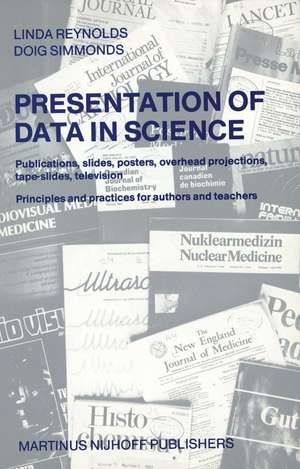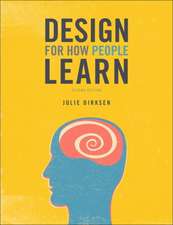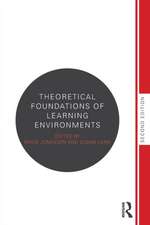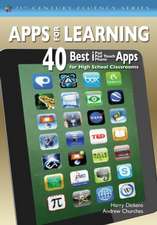Presentation of Data in Science: Publications, slides, posters, overhead projections, tape-slides, television Principles and practices for authors and teachers
Autor L. Reynolds, D. Simmondsen Limba Engleză Paperback – 30 sep 1982
Preț: 345.71 lei
Preț vechi: 363.91 lei
-5% Nou
Puncte Express: 519
Preț estimativ în valută:
66.16€ • 68.68$ • 55.17£
66.16€ • 68.68$ • 55.17£
Carte tipărită la comandă
Livrare economică 19-25 martie
Preluare comenzi: 021 569.72.76
Specificații
ISBN-13: 9789024730544
ISBN-10: 9024730546
Pagini: 232
Ilustrații: 232 p. 52 illus.
Dimensiuni: 156 x 244 x 12 mm
Ediția:1984
Editura: SPRINGER NETHERLANDS
Colecția Springer
Locul publicării:Dordrecht, Netherlands
ISBN-10: 9024730546
Pagini: 232
Ilustrații: 232 p. 52 illus.
Dimensiuni: 156 x 244 x 12 mm
Ediția:1984
Editura: SPRINGER NETHERLANDS
Colecția Springer
Locul publicării:Dordrecht, Netherlands
Public țintă
ResearchCuprins
1. The legibility of type.- 1.1. Introduction.- 1.2. Investigating legibility.- 1.3. Type forms.- 1.4. Type size.- 1.5. Line length.- 1.6. Line spacing.- 1.7. Letter and word spacing.- 1.8. Justified versus unjustified setting.- 1.9. Margins.- 1.10. Single- versus double-column layouts.- 1.11. Paper and ink.- 2. The presentation of text.- 2.1. The visual representation of information ‘structure’.- 2.2. Continuous text.- 2.3. Bibliographies and references.- 2.4. Indexes.- 3. The presentation of tables.- 3.1. Structure.- 3.2. Layout and typography.- 4. The presentation of graphs, charts and diagrams.- 4.1. The relative merits of different kinds of illustration.- 4.2. The content of illustrations.- 4.3. General principles of presentation.- 4.4. The presentation of graphs and charts.- 5. Printed publications.- 5.1. Introduction.- 5.2. Graphic standards for graphs, charts and diagrams in printed journals.- 5.3. Guide lines for camera-ready copy.- 5.4. Original artwork versus copies.- 5.5. Overlays and cover sheets.- 5.6. Marks of identification.- 5.7. Sending artwork to the publisher or printer.- 6. Slides.- 6.1. Introduction.- 6.2. Planning a slide presentation.- 6.3. The content of slides.- 6.4. Graphic standards for slides.- 6.5. The use of colour.- 6.6. Testing slides.- 6.7. Projection of slides.- 6.8. The design of lecture theatres.- 7. Posters.- 7.1. Introduction.- 7.2. The content of posters.- 7.3. Useful equipment for poster production.- 7.4. Graphic standards for posters.- 7.5. Packing and transporting poster displays.- 8. Overhead projection transparencies.- 8.1. Introduction.- 8.2. Graphic standards for transparencies.- 8.3. Techniques in the use of OHP transparencies.- 8.4. Testing OHP transparencies.- 9. Tape-slide programmes.- 9.1. Introduction.- 9.2.Planning a tape-slide programme.- 9.3. Writing the script.- 9.4. Graphic standards.- 9.5. The recording.- 10. Television.- 10.1 Introduction.- 10.2. Graphic standards for television.- 11. Materials, equipment and working comfort.- 11.1. Introduction.- 11.2. Basic essentials for black-and-white artwork.- 11.3. Other useful items for black-and-white artwork.- 11.4. Additional materials for colour and OHP work.- 11.5. Working comfort.- 12. Basic techniques.- 12.1. Care and preparation of paper.- 12.2. Ink work.- 12.3. Correcting errors in ink work.- 12.4. Use of dry-transfer materials.- 12.5. Use of self-adhesive tones and colours.- 12.6. Simple object drawing for line diagrams.- 13. Working method.- 13.1. Planning the illustration.- 13.2. Making the draft.- 13.3. Using the draft.- 13.4. Making the final artwork.- 13.5. Making additions to the artwork.- Literature.
Recenzii
`Publish or perish is a cliché, but true and we all take it seriously. As a result the total medical output doubles about every seven years. Some books form important stepping stones to greater production, and easier life and the more efficient use of resources. This book is one to be recommended highly to all who write, lecture and teach.'
Journal of the Royal Society of Medicine, 75 (1982)
`...one of the most useful practical publications to appear in many a long day. It can be highly recommended.'
Journal of the Institute of Health Education, 23:3
`...Departmental Libraries that do not already possess it should add it to their shelves.'
Journal of the Royal Society of Medicine, 78 (1985)
`Presentation of Data in Science is an excellent book, and every serious research unit producing papers and preparing lectures should have a copy on its shelves - and should use it.'
British Medical Journal
Journal of the Royal Society of Medicine, 75 (1982)
`...one of the most useful practical publications to appear in many a long day. It can be highly recommended.'
Journal of the Institute of Health Education, 23:3
`...Departmental Libraries that do not already possess it should add it to their shelves.'
Journal of the Royal Society of Medicine, 78 (1985)
`Presentation of Data in Science is an excellent book, and every serious research unit producing papers and preparing lectures should have a copy on its shelves - and should use it.'
British Medical Journal










